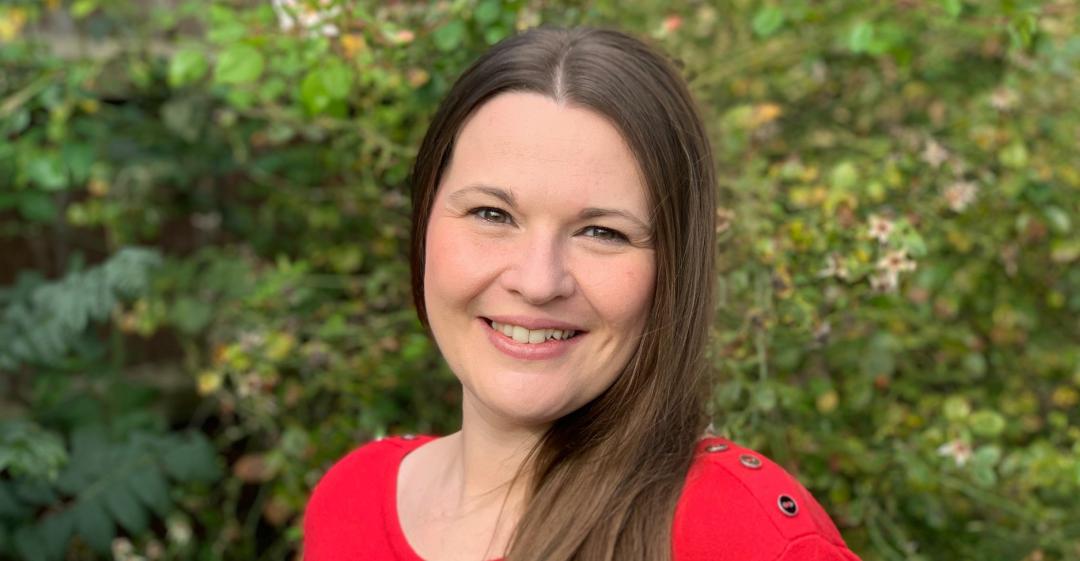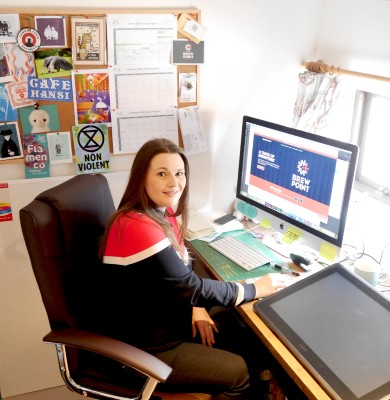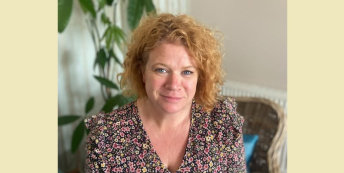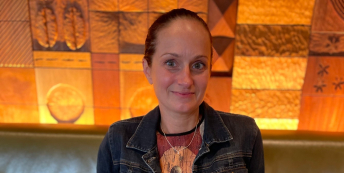“I couldn’t shake the feeling that I was missing out on something important in life.”

What work were you doing previously?
I was Head of Network Supply Chain for a global tech company.
What are you doing now?
I’m a freelance graphic designer and illustrator.
Why did you change?
I didn’t set out with a specific career path in mind.
When I left school, I drifted into an office job at a mobile phone company, and that led to a ten-year career in logistics.
I took my work seriously, focusing on doing well and earning as much as I could. On paper, I was a success – I’d worked my way up the ladder in a competitive male-dominated industry, and I was making good money.
But the more successful I became, the more exhausted I felt. I was working around 50 hours every week, and then I’d have to respond to texts and messages from my boss on weekends.
There was a clear expectation that I should be available all the time, to do work that didn’t inspire me in any way.
When was the moment you decided to make the change?
Things became so bad that I was eventually signed off from work with stress.
I realised how unhappy my career made me, and how desperate I was to make a change.
How did you choose your new career?
As I built my corporate career, there had been a constant feeling in the background that I was missing out on something important in life… a feeling I now describe as a 'creative nag!'
I didn’t want to ignore that feeling anymore, so I made the decision to leave my job, and find a less demanding part-time role that would help me explore some creative ideas.
I wanted to do something artistic, so I found a course at an adult community college that taught Photoshop and design. That led on to studying for a degree in graphic communications.
The degree involved an internship, to help me gain some direct experience, and I landed my first freelance client through a live brief set during my final year at college.
Are you happy with the change?
I’m so happy!
I can’t believe that I’ve been able to create this amazing career for myself – I feel like a completely different person.
Instead of the ‘Sunday-night dread’ I used to experience when I thought about starting a new week at work, I wake up every morning feeling happy and excited.
What do you miss, and what don’t you miss?
I was good at my job, and my career had progressed well, so there was a certain sense of validation from that, and a feeling that I was someone 'important'.
I missed that feeling at first. But these days, I measure success in happiness and fulfilment, rather than status.
How did you go about making the shift?
I couldn’t afford to keep procrastinating, so I joined Careershifters' Career Change Launch Pad to give me a push in the right direction.
I found that not only was it possible for me to make the change I needed, but that I could draw on support from other people who were in the same position as me. It felt as though I’d given myself permission to change my career.
But the shifting process wasn’t easy, and it definitely didn’t happen overnight.
For example, I tested out a lot of other ideas before I discovered my love for graphic design, including doing some painting, and taking piano lessons!
Then, it was all about learning the principles of design, and soaking up valuable knowledge and experience from my teachers and mentors. I committed myself to starting my career all over again.
How did you handle your finances to make your shift possible?
I was lucky, in that I had some savings I could draw upon at the start.
I also discussed the decision to go part-time with my husband, and we made some cutbacks. He then supported me in leaving work altogether to concentrate on my degree.
What was the most difficult thing about changing?
I found it hard to change my mindset, so I could let go of the outwardly successful career I’d worked so hard to build.
That status was all I knew, and when I left my job, a small part of me screamed, “What have I done?” It felt like I’d been split in two – I didn’t want my old career anymore, but I didn’t know what the new one would look like yet.
There was so much uncertainty along the way, which felt scary. I constantly questioned whether or not I was really capable of changing my career, and if I was talented enough.
What kept me going was an unshakable belief that unless I did something new, I would be stuck with the ‘old’ forever. So I had to ignore all the doubting voices inside my head, and throw myself into the learning process.
Luckily, the further I threw myself in, the more my passion for design grew! But even then, it wasn’t until I was half-way through my design course that something ‘clicked’, and I knew that I was on the right path.
Gaining professional qualifications has also helped me grow confidence in my design skills, and beat the feeling of ‘impostor syndrome’.
What help did you get? 
My friends and family were fantastic at reassuring me when I needed it.
In fact, when I started my shift, I found that none of my friends were surprised – not just that I was changing my career, but that I was going to do something artistic. They had known all along that I was creative, and that gave me such a boost.
I’ve also met some hugely inspirational people along the way, including the teacher on my first design course, who'd started his career as an accountant!
Later on, I discovered that one of my degree tutors also ran a group for local creatives. We realised that we had a lot in common, and we’ve since built a strong collaboration through our design skills that I value enormously. That has helped me find more clients, and develop a reputation in the design community.
What have you learnt in the process?
You’re never too old to change your career.
I started my shift with a lot of hang-ups about my age, and that I’d probably left it too late. I was 35 when I started my design course, and I felt ridiculous walking into college on that first day.
I thought the course would be full of youngsters, but I was pleasantly surprised to find it was a mixed bag of people, including some who were older than me.
Since then, I’ve actually found that having more life experience to draw upon has brought a richer element to my design career, as I’m able to make stronger creative connections.
I had also assumed that my previous career skills would be lost, but I found that my experience in areas like managing client relationships, project management, and understanding business processes was a huge asset, especially when it came to setting up my freelance business.
What do you wish you'd done differently?
I wish I hadn’t kept on ignoring that 'creative nag' and started my career change earlier.
I spent so much time procrastinating and feeling scared of the unknown that I look back now, and I feel daft!
What would you advise others to do in the same situation?
It all starts with the knowledge that if you’re unhappy, things won’t change unless you try something new.
That will mean taking risks, and living with uncertainty. It’s all about learning how to get comfortable with that, and doing your best to look to the future rather than the past.
To find out more about Carli's work, visit carlipfurtscheller.com.
Carli took part in our Career Change Launch Pad. If you're ready to join a group of bright, motivated career changers on a structured programme to help you find more fulfilling work, you can find out more here.
What lessons could you take from Carli's story to use in your own career change? Let us know in the comments below.



